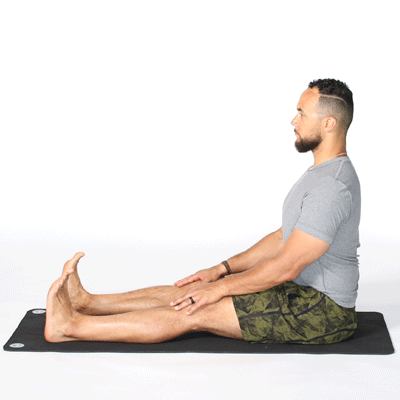
Many people experience knee pain while practicing yoga. Even though it sounds counterintuitive, yoga can be a great therapy for your condition. To learn more about the benefits of yoga for knee pain, visit Outside Learn, an online education hub featuring in-depth courses in fitness, nutrition, and yoga. Click on these links to find out which class is best for you. You can find a class to suit your schedule and level.
The butterfly position is one of most popular yoga knee pain exercises. The butterfly pose, which is a seated position, requires that the soles of your feet are together and the knees are bent wide. This exercise is beneficial for groin and hip flexors, without placing excessive strain on the knees. To avoid further stress on the knees, you may choose to perform this exercise with slightly bent or straight legs. In order to avoid straining your knees, you should switch sides if you are experiencing any discomfort.

Your knee micro-bend is key to making yoga safe for your knees. This posture prevents hyperextension. Additionally, it stimulates your knee muscles which in turn increases strength. The best pose for knee pain is the lunge. However, be gentle with yourself and modify as necessary. Although yoga can't provide a quick fix for your pain, it can help you reduce it and maintain good health.
The best pose to do if you have knee pain is the kneeling position. This can be done with towels, blankets or folded blankets. To hold this posture, pull your calf muscles back and seat your hips between your ankles. You can pull your buttock flesh up and raise your knees. Hold this position for five to 8 breaths. If you can, hold it longer.
A knee-healing exercise is one of the best ways for extending the knee. It can place a lot on the knees and strain ligaments. You should not do this pose if your knees are sensitive or you are experiencing joint pain. Consult your doctor if you have had an injury in the past. This will allow you to get the proper treatment and diagnosis. To strengthen your body and alleviate pain in your knees, you should learn yoga.

Some types of yoga may cause knee pain. You should avoid placing pressure on your knees by avoiding asanas. However, you can modify these poses in order to reduce pressure on your knees. To relieve pressure and pain at your knee, you should use a yogablock. The blocks can help you maintain a good balance during the pose. If you have suffered a knee injury, it can be useful to modify some asanas. To prevent any kind of discomfort from occurring during yoga, contact a medical professional immediately.
FAQ
What is a good 7-day workout schedule?
A seven day exercise program should include cardiovascular training (running or biking), strength exercises (using freeweights, weight machines) and one flexibility/core workout. Each activity should be performed at least once each week. Each session should not take more than 45 mins.
Cardiovascular Exercises: Swimming, Cycling, Running
It is important to complete at least 60 minutes of cardio per week. Try to do 75 minutes per semaine for the best results. Cardio exercise can stimulate blood flow and increase muscle growth.
Strength Training
Cardio exercises focus on the heart and lungs while strength training targets muscles and bones. Strength training builds lean muscle mass, which helps burn calories even when resting.
Flexibility & Core Workouts
Flexibility and core workouts are great ways to strengthen your entire body. Both yoga and Pilates are excellent options.
Are There Any Benefits to Yoga?
Yoga has been around since ancient times, and it has recently gained popularity. Celebrities and ordinary people love yoga.
Yoga is great because you can stretch your muscles and strengthen them. Yoga is also great for calmening your mind and relaxing.
Yoga is more focused on breathing than other forms of exercise.
For balance and flexibility, there are many poses you can do.
Do I have the obligation to exercise every day or just on occasion?
No! At least 30 minutes moderate-intensity exercise five days per week is a good goal. That means walking fast enough to be slightly out of breath or biking hard enough to sweat.
Is it true that kidney stones can be caused by overeating protein?
Protein helps maintain healthy bones and tissue. Too much protein can cause calcium to be excreted through the urine. In turn, this can result in kidney stones.
It is important that you note that not all people develop kidney stones when they consume more than 2 grams of protein per kg (2.2 pounds). High amounts of protein can be consumed by some people without causing kidney stones.
By watching how much sodium you consume, kidney stones can be prevented. The kidneys regulate the amount of sodium they consume. A high level of sodium can increase the risk of developing kidney stone.
You can also reduce your intake of proteins if you develop kidney stones. Protein provides about half of the daily caloric needs for most adults. It is possible to lose weight by cutting down on your intake of proteins.
If you do decide to eat more protein, don't go overboard. Do not eat more than 20% of your daily calories from protein.
How to Build Muscles Fast
It is important to eat healthy food and lift weights frequently in order to quickly build muscle.
When you're fresh and ready to do something, early morning is the best time for working out.
Try exercises like squats and bench presses.
Consider trying different weight training programs and drinking plenty of water throughout each day.
Statistics
- Are You One of the 20% of Guys (mh.co.za)
- An estimated calorie range for moderately active adult males falls between 2,200 to 2,800 calories per day, depending on age. (eatright.org)
- According to the American Heart Association, blood pressure should be checked at least once every two years, beginning at age 20. (my.clevelandclinic.org)
- Candidates and applicants must pass all four tests at 70% (minimum level) to graduate from Basic Deputy U.S. Marshal (BDUSM) Training. (usmarshals.gov)
- 10 pounds in a month is likely during a lean bulking phase, especially for beginners. (muscleandstrength.com)
External Links
How To
What nutrients do men need each day?
For healthy growth and development, men need to eat a balanced diet. Vitamins, minerals, vitamins, nutrients, carbohydrates, fats and fiber are all essential for the body.
Males also require specific nutrients at certain times of the day. To give you an example, the body uses energy it receives from food to make hormones and antibodies. You use protein to build muscles and repair damaged tissue when you wake up.
At night, your body breaks down fat and stores the extra energy as glycogen. During this time, your body needs fewer calories but still needs sufficient nutrients. If you feel hungry, you can have a snack in the evening.
When you work out, you need adequate levels of carbs and protein to fuel your muscles. If you exercise hard, you might feel muscle soreness.
To prevent this, you should eat carbs as well as protein within the first two hours after training. Your body will break down stored glycogen to provide glucose for energy.
You must also eat protein right after you finish your workouts. This prevents muscle tissue from being broken down while you are sleeping.
During periods of intense physical activity, your body produces lactic acid. It is a form of lactic acid that builds up in the bloodstream. This causes fatigue. Avoid this by eating foods rich in carbohydrates such as fruits or vegetables.
Carbohydrates can give your body the energy it requires to recover from intense exercise.
In addition, you may want to include lean meats, fish, eggs, milk, cheese, yogurt, beans, nuts, and seeds into your diet.
All these foods are high-quality sources of protein. Protein is important for muscle growth and repair. Protein provides the amino acid your body needs for testosterone and sexhormone production.
Good skin, hair, and joint health requires adequate dietary fats. Healthy men need between 20% and 35% of their total caloric intake from fat.
Fat protects your heart from cancer and keeps it strong. It helps keep your brain working properly.
Most of the fat you need can be obtained from vegetable oils, including sunflower oil (or soybean oil), peanut oil, peanut oil, soybean oil, and peanut oil.
These oils contain high levels of monounsaturated fat acids (MUFAs). MUFAs are good for lowering cholesterol and reducing inflammation. They protect cells against damage from free radicals.
Saturated fats (SFAs), are found mainly in animal products such as meat, milk products, and butter. SFAs can raise LDL ("bad") cholesterol levels and increase triglycerides. They can also increase weight and reduce belly fat.
Polyunsaturated fats (PUFAs) are found in plant-based sources like vegetable oils, nuts, seeds, and grains. PUFAs help improve cardiovascular function, and lower inflammation. They are also good for controlling blood sugar and cholesterol.
Low HDL ("good") cholesterol is a common cause of erectile dysfunction in men. Saturated fats are a major source of bad cholesterol. This lowers good cholesterol.
Red meat and pork are a common source of prostate problems in men who eat a lot. Nitrites convert to nitrosamines when cooked at high temperatures. These compounds can cause cancer.
Most processed meats contain nitrites or other harmful chemicals. They should be avoided.
The American Heart Association recommends limiting red meat intake to two meals per week. Instead, choose poultry and fish, legumes, tofu or whole grain bread as your main source of protein.